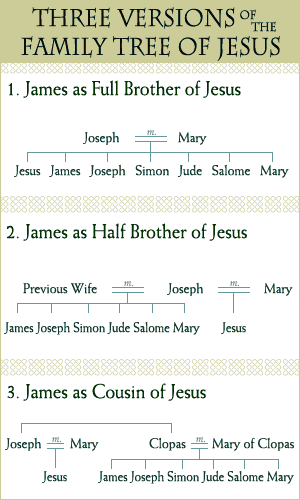James: Several New Testament passages (read them in context) refer to Jesus' siblings, including James. In Matthew 13:55-56, villagers are skeptical of Jesus' powers, saying: "Is not this the carpenter's son? ...Are not his brothers James and Joseph Simon and Judas? Are not his sisters with us?"
In addition to gospel references, the "brother of the Lord" is mentioned in several New Testament books. 1 Corinthians says that the risen Jesus appeared to James, and several sections of Acts detail James' leadership of Jerusalem's early Christians. While it's difficult to piece together what James' attitude toward his brother might have been before Jesus' crucifixion, it seems clear that James became a Christian afterward.
The first-century Jewish historian Josephus also refers to James. Josephus' account is one of the best non-biblical proofs we have that Jesus had a brother. This text, which scholars consider generally reliable, describes "James, the brother of Jesus who was called the Christ," according to Biblical Archaeology Review. Josephus' account says that James was condemned to death in 62 C.E.--about 30 years after the death of Jesus, during the rule of the Roman governor Festus. "He was able to live in relationship both with Christian Jews and non-Christian Jews, and in fact when he was executed by the high priest it eventually caused the high priest to be dismissed," says scholar John Dominic Crossan, member of the liberal Jesus Seminar. "In other words, he had pretty powerful friends, who probably weren't Christian."
The recent find doesn't add to historical knowledge about James, though the box--if and when it is placed on public display--will likely drive much more interest in James.

Above: Protestant (#1), Eastern Orthodox (#2), and Catholic (#3) views of Jesus' family. Source: Biblical Archaeology Review
Mary: Despite her prominence in some Christian traditions, the gospels say relatively little about Jesus' mother. Luke 1:26 says Mary was a young girl or virgin (scholars debate the meaning of "parthenos," the Greek word used) when she conceived Jesus. However, both Luke and the first chapter of Matthew relate that Mary conceived Jesus "by the Holy Spirit." This is the basis for the traditional belief, shared by virtually all Christian denominations, in the virgin birth.
However, the Roman Catholic and Eastern Orthodox Churches teach that Mary remained a virgin all her life, even after the birth of Jesus. Catholic scholars in particular have carefully scrutinized scriptural accounts that might imply Mary gave birth to additional children. Catholics may be troubled by archaeological evidence corroborating these Bible accounts.
Historically, some Catholic scripture experts have contended that the Greek word "adelphos," used in the New Testament passages which describe Jesus' brothers, can mean a cousin or other relative, not necessarily a blood brother--and therefore, mentions of James did not contradict the belief that Mary remained a virgin.
Others, such as Crossan, read the scripture differently. "In Mark's gospel, Jesus has brothers, four of them in fact. And two sisters," Crossan says. "And his father is Joseph and his mother is Mary....And the normal meaning for brother--well, you mean brother."
The Aramaic inscription on the ossuary of James uses the word "akhui" for brother. According to Protestant scholar Ben Witherington III, both the Aramaic word "akhui" and the Greek word "adelphos" usually refer to a blood brother. Both languages have other words for "cousins or more distant kin," says Witherington.
Some Christians refer to Mark 6:3, where Jesus is called the "son of Mary"--not, as would be expected, the "son of Joseph." That Jesus is called "son of Mary," they say, supports the belief that Mary conceived Jesus through the power of the Holy Spirit. The ossuary could be seen as contradicting that argument because in referring to James, the ossuary inscription uses the expression "son of Joseph."
The Catholic belief in Mary's perpetual virginity is closely tied to one of the few ex cathedra--infallible--teachings of the Church, that of Mary's bodily assumption into heaven. In Munificentissimus Deus, Pope Pius XII declared that "the Blessed Virgin Mary's bodily Assumption into heaven--which surely no faculty of the human mind could know by its own natural powers, as far as the heavenly glorification of the virginal body of the loving Mother of God is concerned--is a truth that has been revealed by God and consequently something that must be firmly and faithfully believed by all children of the Church."
Ultimately, says Crossan, the ossuary discovery will "raise again all the issues of history and faith, of virginity taken literally or metaphorically. It won't prove anything, but it will make people think about it."
Joseph: Until now, there was no non-textual evidence about the existence of Joseph. According to the gospels, Joseph was present at Jesus' birth and circumcision, protected the baby from the massacre of the innocents, and found a 12-year-old Jesus in the Jerusalem temple when he was separated from his family.
Because of the virgin birth doctrine, most Christian traditions hold that Mary's betrothed, Joseph, was not the biological father of Jesus. Catholicism usually refers to Joseph as Jesus' "foster father," and praises his role in protecting the Holy Family during their journey to Egypt, among other events. Pope John Paul II has elevated St. Joseph's status in the church, saying that "Joseph of Nazareth shared the mystery [of the Incarnation] like no other human being except Mary."
An Orthodox Christian tradition holds that Joseph was married, had children, and was widowed prior to his betrothal to Mary. Joseph's children would have been Jesus' step-siblings nominally, if not biologically. This view is not incompatible with Catholic teaching, but is not widely held by Catholics. Because neither Catholic nor Orthodox teaching allow for Jesus to have siblings that were the natural children of Joseph and Mary, the ossuary inscription may be seen in the same problematic light that the gospel references are.
Protestants also believe that Mary conceived Jesus through the Holy Spirit. But in general, Protestants don't describe Joseph literally as a "foster parent" to Jesus. Most Protestants don't dwell on Joseph's role much at all, except during the annual Christmas pageant.
If nothing else, the ossuary inscription may make even more tangible the belief that Jesus was, as Crossan says, "a real human being with a brother, with a father...it brings Jesus down to the earth."

